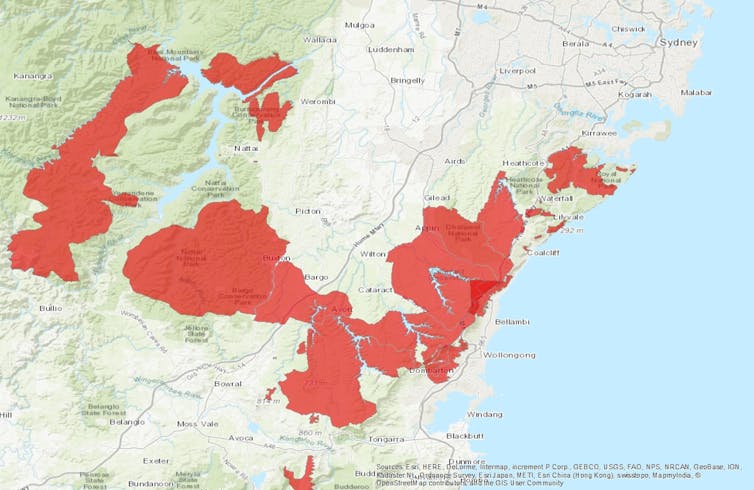Drought, wind and heat: when fire seasons start earlier and last longer
GUEST OBSERVATION
The New South Wales Rural Fire Service declared the earliest total fire bans in its history this week. The entire state was declared to be in drought on the same day.
The combination of winter drought and hot, dry weather has made dangerous fires increasingly likely.
Already this week two fires on the south coast have escaped containment lines and destroyed houses. The weather during these fires was 6℃ warmer than the August average, dry and extremely windy. The wind speed peaked at 104 kilometres an hour in Bega and 85km/h in Nowra, two towns close to where fires broke out.
Under these conditions, bushfires will spread quickly, produce large numbers of embers and are hard to stop.
Our fire seasons now start earlier and last longer. This means we’re increasingly likely to see repeats of historically large fires threatening residential areas.
Fire seasons are longer
Current dry conditions are reflected in the maps of live fuel moisture produced by Dr Rachael Nolan of Western Sydney University.
This method tracks the weekly moisture content of the forests in southern Australia, as observed by NASA’s MODIS satellite. The latest map shows a patchy distribution of dry areas and a drying trend over recent weeks.
It looks like NSW’s fire season has already started, and it’s likely to be bad. Last year’s fire season also extended well into autumn, with serious bushfires burning in mid-April.
Fire agencies usually enjoy a six-month break from bushfires between April and September, but this year they had only three months’ respite.
This reflects evidence of a trend toward more extreme fire weather over the past 30 years, and lengthening fire seasons.
This problem is being keenly felt in western United States, where fire agencies have warned that the fire season now lasts all year round. Not only that, there is clear evidence climate change is increasing fire activity in the United States; the record for the largest fire in California history has been broken two years in a row.
Alarming precedents
The most damaging fire season for NSW in the past 30 years was in October 2013 when the Linksview fire destroyed 200 houses in the Blue Mountains.
The build-up to that season was eerily similar to this year, with a winter drought and bushfires in September, but the moisture maps show that the forests are drier now than at the same time in 2013, and we have already seen serious bushfires in August.
As we move into September and October, the weather will warm, which means any remaining moisture in the ground and plants will evaporate even faster than at present, and fires will be more intense and spread faster. The only thing that will reduce the risk is soaking rain of at least 100mm.
whether or not that will occur in the next two months is almost impossible to predict. At the moment it seems unlikely. The Bureau of Meteorology’s latest seasonal forecast, issued on August 16, considers it likely that dry conditions will persist for the next three months.
The heightened risk of bushfire this season should be a wake-up call for residents in bushfire-prone areas. Most people in really risky areas such as the Blue Mountains are well prepared, but many people who are a little more removed from the forests are not aware of the risk.
For example, many residents of Wollongong probably don’t know this October is the 50th anniversary of the great 1968 fires that swept down the Illawarra Escarpment into the suburbs of Figtree, Bulli, Austinmer and others.
The footprint of the 1968 Illawarra fires, which burned through residential areas.
If the same footprint of fire were to occur again, some 5,000 houses would be affected. The present indicators suggest a repeat of this event is more likely than at any time for decades.
Residents need to prepare a bushfire survival plan, which includes a decision on whether to stay and defend or to leave as soon as they learn about a nearby bushfire.
Current research at University of Wollongong suggests that the biggest influence on the risk of house loss during a bushfire is the actions that the residents themselves take. This includes ensuring that natural and man-made fuels are kept to a minimum in the garden, especially close to the house, and also defending the house from spot-fires caused by embers.
The Rural Fire Service has a wealth of advice for preparing for bushfires on its website.
We’re look at a torrid upcoming fire season, dependent on the vagaries of the Australian climate. Either way, now is the time for people to brace themselves and get prepared.
Owen Price, Senior Research Fellow, Centre for Environmental Risk Management of Bushfires, University of Wollongong
This article was originally published on The Conversation. Read the original article.


